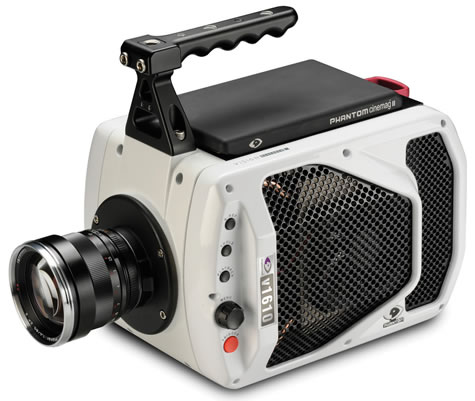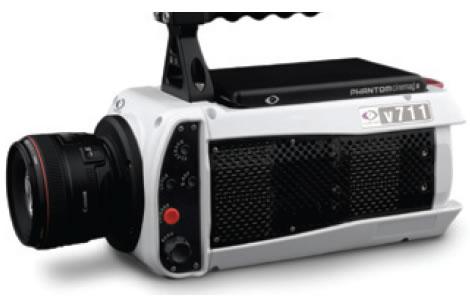Cameras: News and Updates
| Case Study - Phantom Cameras Used in Testing Grenades from 17th Century French Shipwreck By StudentFilmmakers.com posted Feb 10, 2012, 14:34 |
Download Case Study:
http://www.visionresearch.com/uploads/Docs/CaseStudies/CS-WEB_LaBelle.pdf
In 1684, French explorer Robert Cavelier, sieur de La Salle, led a fleet of four ships in an attempt to start a French colony at the mouth of the Mississippi River and dominate the Gulf of Mexico. But his journey became riddled with hardship.One vessel was taken over by privateers, another sank, and the Mississippi River was not situated where the maps had indicated. Instead, La Salle's expedition unknowingly landed on the Texas coast, and in February of 1686, the last of his vessels, La Belle, sank in a storm.
Following the loss of the colony's last ship, La Salle attempted to lead the settlers on foot to the nearest French settlement, thousands of miles away. While a scant few made it back to France, many succumbed to the elements, while La Salle himself was murdered by his own men. This historic event marked the end of the first permanent European settlement in Texas.
For more than 300 years, the wreckage of La Belle remained an afterthought.Then, in 1995, Texas state archaeologists discovered one third of the ship at Matagorda Bay, about 120 miles south of Galveston, marking one of the most important archaeological finds of the century. A major excavation was launched by the state of Texas using a large, steel structure called a cofferdam – which was built around the ship to enable seawater to be pumped out. Over the next year, Texas Historical Commission archaeologists recovered the entire shipwreck, including the hull of the ship, as well as an array of important artifacts. These artifacts included hundreds of thousands of glass beads, tons of musket shot, bronze hawk bells, and three bronze cannons that were meant to defend the colony from attackers. "Many of these artifacts were likely remnants of the colony's secret goal – to steal the Spanish silver mines in northern Mexico," said Eric Ray, La Belle researcher at the Corpus Christi Museum of Science and History in Corpus Christi, Texas.
Archaeologists also discovered a collection of ceramic pots that were sealed by cork and fabric. Inside each pot was a mass of degraded gunpowder and an iron grenade. The ceramic pots, dubbed "fire pots," were of particular interest to Ray and his team because they represented an early form of hand grenade. The word "grenade" derives from the French word for a "small explosive shell." While both ceramic and iron grenades are known from the archaeological investigation of other sites, the composite forms found at La Belle were unique, according to Ray. "There is only one historical reference to an iron grenade inside a ceramic pot,and it's from a French armament treatise released the same year La Belle sailed. The action and effectiveness of this type of device were unknown, and we were intrigued. So, in order to learn more about how these grenades functioned, there was only one option for us – to build new ones."
Faster Than the Speed of Sound
Ray joined forces with artists and sculptors at nearby Victoria College and Texas A&M University – Corpus Christi, and together, they began the undertaking of building new ceramic pots and iron grenades. After months of replicating the grenades, the research team was granted permission by the Corpus Christi Police Department to launch them at the local bomb range. In order to accurately analyze the explosive effects of the grenades, Ray had to invest time in cutting edge cameras that could capture images at ultra-high speeds. "We literally had fragments of iron and ceramic traveling at hundreds of miles per hour in all directions, faster than the speed of sound. We needed a method to record the explosion that would yield the most accurate results in helping us formulate an understanding of how the grenades operated," he noted. With the sophisticated, powerful features of Vision Research's Phantom v710 and v1610 high-speed cameras in tow, the team performed 11 grenade launching tests in two days, documenting significant information with the Phantom cameras as part of the study of La Belle.
To pinpoint the effectiveness of the grenades, the explosions were measured on several merits, including speed, velocity, shrapnel effect, and the size of the shock waves. More specifically, the researchers wanted to hone in on the intervals between the slow explosions of the ceramic pots and the fast explosions of the cast iron grenades. This was important, according to Ray, because "when an explosion occurs from a grenade, the force of the explosion compresses the air and creates an expanding area of denser air, which travels outward supersonically. This is called a blast wave. This boundary between the normal atmosphere and the denser front of the blast wave was what we wanted to record," he explained.Since the blast wave travels much faster than the speed of sound, the ultra-high frame rates offered by the Phantom cameras enabled the team to ensure that there was a shock wave and to measure its speed. The team was also able to track the blast wave and confirm that it was the shock wave and not the debris that their pressure devices were reading. Furthermore, the cameras allowed the team to measure the velocity of the fragments as they left the grenade, which was important in determining the severity of their damage.
With the Phantom v710, the researchers were able to record full-scale explosions and capture their impact at ultra-high speeds, up to 7,500 frames per second (fps) at the camera's full 1280 x 800 resolution. At reduced resolutions, the researchers were able to attain even higher frame rates, up to 1,400,000 fps.With the powerful v1610, images were captured up to an impressive 16,000 fps at the camera's full resolution of 1280 x 800. At reduced resolutions, the v1610 delivered frame rates of 650,000 fps. By reducing the image size, the data from the sensor can be moved more rapidly to memory, resulting in higher speeds.
Additionally, the high-quality, customized CMOS sensors in each camera enabled Ray to overcome lighting challenges during the testing. Because of the speed at which the iron fragments traveled the team could not use any lighting fixtures because they would have been damaged. The performance of the CMOS image sensors allowed for the capture of outstanding images even in low lighting conditions, without the need for extra lighting.
High-Speed Imaging Equals High-Quality Results
The cines produced from the cameras enabled Ray to document several important facts about cast iron grenades, such as the varying speeds of the fragments. "At the bomb range where we conducted the testing, we set up human cutouts made of plywood as targets. Some of the ceramic fragments travelled as slow as 50 or 60 miles per hour, but some traveled as fast 1,500 miles per hour. One of the plywood cutouts had a large piece of ceramic pot embedded more than halfway through it," he explained. The cameras also allowed Ray and his team to examine the extremely short time scale of an explosion and let them see details, such as the double-explosion of the fire pots. They were able to study the slow explosion of the ceramic pot, and then the iron grenade explosions, followed by the shock wave that accelerates the gases and fragments.
This data was instrumental in helping the team draw important conclusions about the artifacts found on La Belle, one being that the fire pots would have been a more effective weapon for terrestrial use than for ship-to-ship combat. "There would have been a small region of fatal pressure, probably six feet, followed by a lot of damage to people and structures from the iron and ceramic fragments. Also, we concluded that though the grenades would not have necessarily caused fires, the bits of gunpowder in the ceramic pots were strong enough to cause severe damage to humans. They would stick on human skin and continue to smolder, causing a considerable amount of pain and burning, as well as scarring and skin damage. These were severe weapons, not to be taken lightly," Ray commented.
Many of La Belle's artifacts are on display at the Corpus Christi Museum of Science and History, as well as at seven other museums around Texas. The hull of the ship is also undergoing chemical treatment for preservation. The research of cast iron grenades remains an ongoing project at the Corpus Christi Museum of Science and History. "There is a lot of continual historical research being done to place our grenades in the proper context, and we are extremely happy with the results from our two days of testing. In a continual effort to preserve La Belle, some of the videos from the study are available to the public here at the museum, and will be available soon on the museum's website."
Resources:
http://www.visionresearch.com/uploads/Docs/CaseStudies/CS-WEB_LaBelle.pdf

